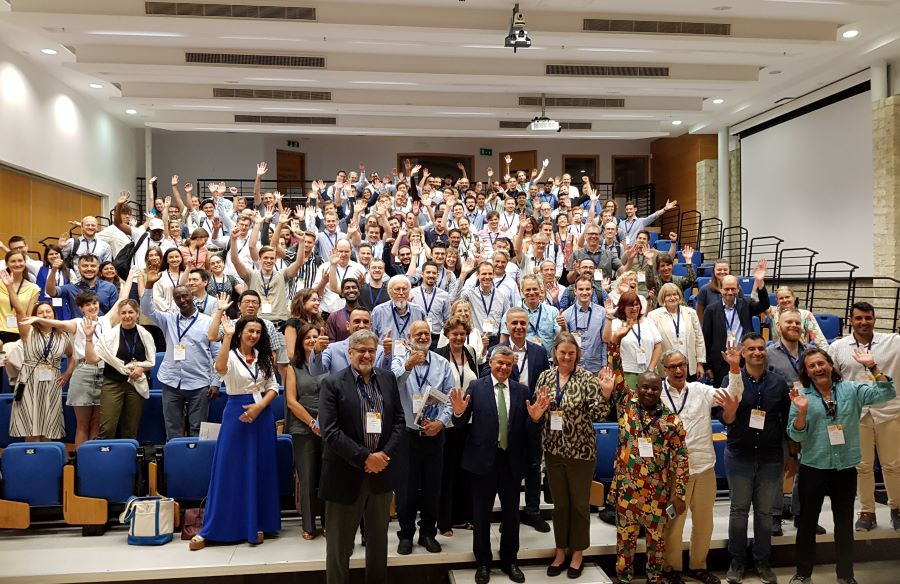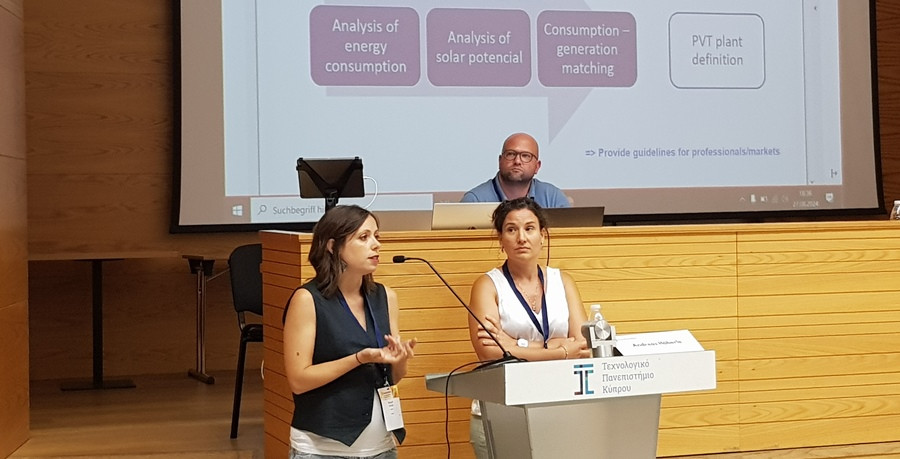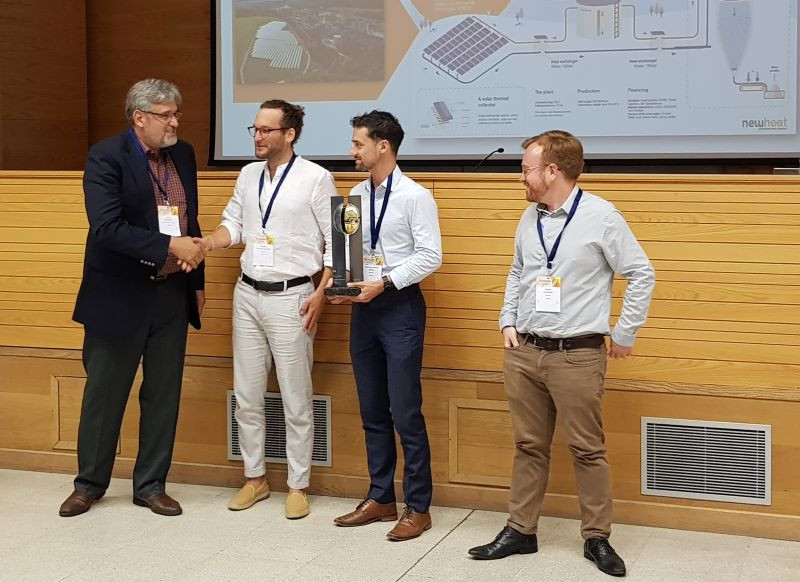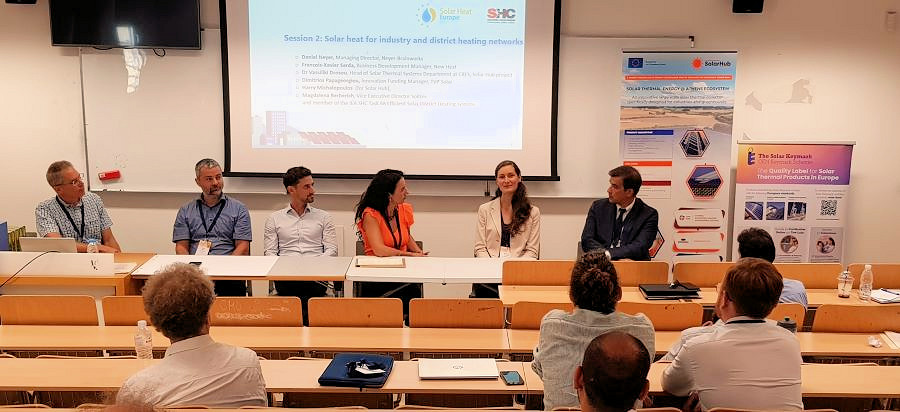Posted: September 6, 2024

Photos: Bärbel Epp
EuroSun in Cyprus attracted around 200 visitors from over 40 countries. They all recognized that solar heat technologies are an important pillar of the energy supply on this island. 92 % of the houses, 53 % of the hotels and a considerable number of industrial companies use solar heat. “Solar Energy plays, and will continue to play, a vital role in Cyprus's energy mix since it contributes to the enhancement of the country’s security of energy supply, it is cheap and it can be extensively utilized.” With these words, Giorgos Papanastasiou, the federal Minister of Energy, Commerce and Industry, personally opened the event. EuroSun 2024 was the second conference jointly organized by the International Solar Energy Society (ISES) and the IEA Solar Heating and Cooling Programme after EuroSun 2022 in Germany. The Newheat project at the dairy Lactalis Ingredients in France won the IEA SHC Solar Award.
“The atmosphere throughout the conference was extremely good and optimistic. Many young people took part and the parallel sessions were all well-attended”, summarized Conference Chair Alexandros G. Charalambides, Associate Professor at the Cyprus University of Technology.
A special feature of EuroSun 2024 were the keynote speeches introducing each new topic block. Magdalena Berberich, Deputy Director of the German institute Solites, kicked off a series of keynotes with a speech about large thermal energy storages. Interest in seasonal storage in the European heating sector is growing. Berberich reported on a prefeasibility study for the German city of Rostock. This involves four 500,000 m3 heat-storage pits, which are necessary to enable the heat transition in Rostock until 2045. Among other heat sources they are planned to store excess heat from a waste incineration plant – 50 GWh per year. Solites is also currently involved in a storage laboratory, which is built up by the German company Solmax Geosynthetics. It consists of two identical heat-storage pits, the construction and operation of which will be used to test new design features. These include a steeper slope to accommodate more storage volume on the same area and a new design for the floating cover.

Raquel Simón Allué, R&D Engineer at EndeF Engineering (left) and Dr. Maria Herrando from the Spanish institute ITA introduced together their work programme for the Subtask D on PVT Modelling and Monitoring during the task definition workshop about PVT Heating Systems at the first day of the conference.
PVT collectors – a trendy topic
PVT collectors – the topic of the second keynote speech - were popular among the conference participants and were dealt with in various sessions. In her speech, Dr. Maria Herrando from the Spanish Institute ITA introduced the concept of a dual air-water PVT collector. In this case, in a covered PVT collector there is both a water loop and an air channel behind the laminated PV cells, so that heat can be extracted from the same element using both methods. “This PVT collector type has a high versatility, but is slightly more complex and expensive than water-based PVT collectors”, Herrando explained.
Zanil Narsing presented PVT applications in practice in a session about Solar Energy Buildings, organized by IEA SHC Task 66. The Strategy and Partnerships Associate at Naked Energy described an installation with 617 m2 of VirtuPVT collectors for a library in London. The elements consist of 20 cm wide evacuated single-glass tubes, which include a metal absorber laminated to the PV cells and can produce up to 75 °C. The tubes can be installed on a flat roof, so that they do not visually alter a historic building. “To do this, we align the tubes during installation in the racks so that the absorber faces south and we have minimal wasted space”, explained Narsing.

IEA SHC Award winners from the French company Newheat: Thomas Colin de Verdière, Control Engineer, Francois-Xavier Sarda, Industry Key Account Manager, and Alexis Gonnelle, Principal Scientist, received the award from IEA SHC Chair Lucio Mesquita.
Achievements of the solar industry in various countries
The second conference day was marked by an industry session organized by Solar Heat Europe highlighting some of the achievements of the solar heat industry in various countries.
France: Francois-Xavier Sarda from Newheat introduced the outstanding solar process heat plant at the dairy Lactalis Ingredients in Northern France, which won the IEA SHC Solar Award. 10.5 MW of flat plate collectors reduce the site’s gas consumption by 6 %. The innovative part of the solar plant is the process integration: the solar-heated water-air heat exchanger supplies heat directly into the spray dryer tower. In the tower the drops of whey, a by-product of cheese making, are dried to become whey powder for the food industry. As the drying is done by fresh air, the solar loop reaches high efficiencies. Newheat estimates an annual solar yield of 8 GWh which corresponds to 533 kWh/m2.
Cyprus: Andreas Ioannides, President of the Cyprus Union of Solar Thermal Industrialists (EBHEK), listed the reasons for the high penetration of solar water heaters on the Island:
- In 1974 many refugees settled in Cyprus and received solar water heaters for their housing
- In the 1980's the first standard for solar thermal systems was approved. It was like a recipe showing how to produce a proper collector
- Between 2010 and 2017 there was a mandatory regulation that all new buildings had to install a solar water heater
- The government subsidizes the replacement of solar water heaters that are more than 15 years old
Greece: Harry Michalopoulos, CEO of the Greek manufacturer Sammler and Vice President of the Greek solar thermal association EBHE, highlighted the fact that the Greek manufacturers are now run by the second generation. They are investing heavily in new production lines and new factories because of growing export volumes: “At Sammler we sell more than half of our production outside Europe, from Chile to South Korea.”
Uganda: 100 % solar-dried pineapples marketed abroad. This was the success story told by Daniel Neyer from the Austrian consultancy Neyer-Brainworks. Smallholder farmers are involved in the project and harvest pineapples 365 days a year. 80 m2 of flat plate collectors produce the hot water to run a cabinet dryer, whereas the ventilators and auxiliaries are driven by solar electricity to form an autonomous system. If the factory manages to process seven tons of pineapples annually, the investment will pay for itself in five years.
Netherlands: The largest SDH system outside Denmark started operation in the Netherlands in August. A special-purpose company owns and operates the 37 MW plant and has signed a 30-year heat-delivery contract with the municipal utility of Groningen. The field consists of evacuated flat plate collectors of the type MT-Power v4 from the Swiss company TVP.
In the discussion that followed, Dimitris Papageorgious, TVP Innovation Funding Manager, made clear that “Uncertainty is the enemy where infrastructure projects are concerned.” The project developers need long-term economic stability to be able to sign contracts with their heat clients.

Panel discussion at the end of the industry session organized by Solar Heat Europe bringing together industry and research representatives.
Websites of organizations mentioned in this news article: